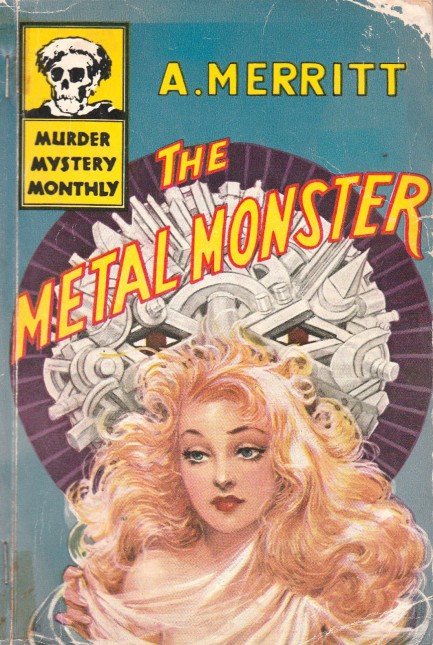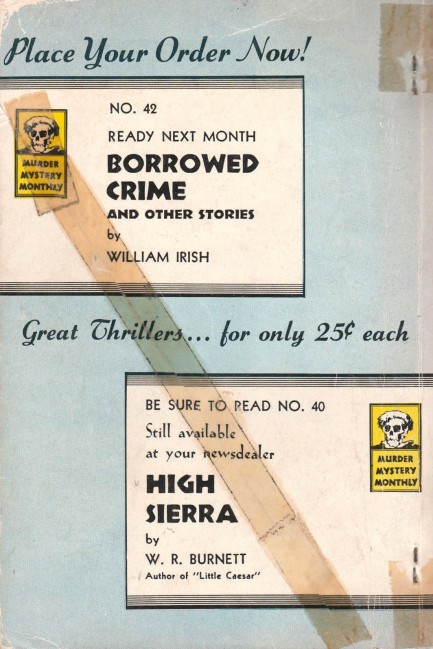| Vintage Pulp | Jul 18 2022 |

The Metal Monster is science fiction as a mind-altering trip.

We usually read novels from the ’40s, ’50s, and ’60s, but we took a trip to the heart of the pulp era with Abraham Merritt's The Metal Monster, which made its first appearance as a serial in Argosy All-Story Weekly in 1920. The above paperback came in 1946 from Avon Publications' Murder Mystery Monthly #41, and has cover art by the always interesting Paul Stahr, who worked extensively with Avon during this period. You can click his keywords at bottom and see all four of the covers by him we have in the website. There are also interesting covers by other artists on later editions of The Metal Monster. We'll try to show you a couple of those later.
In Merritt's tale, four explorers travel into an uncharted Himalayan valley and subsequently are trapped by what lives in the area—Persian soldiers seemingly stuck in time, or whose traditions have gone unchanged for two thousand years. There's something else in the valley too—a shimmering goddess creature named Norhala and her metal swarm, which is usually a blizzard of small geometrical shapes, but can collect into forms as needed, for example a towering monster with six whiplike arms that scythe through the ranks of the Persians, ripping them to shreds. While Norhala has some control over the swarm, we later learn that the creatures came from the stars, feed on sunlight, and eventually eradicate biological life on every planet they colonize. So that's not good.
Merritt's prose brings to mind H.P. Lovecraft, because he similarly tasks himself with describing the indescribable. Lovecraft fans know what that means—the creatures in his mythos are so mindbending as to drive humans insane merely to gaze upon them. Lovecraft challenged himself to describe those beings, and much of the horror in his writing derives from those attempts. But he sometimes took his built-in escape hatch too, ultimately saying the creatures simply were so inhuman they couldn't be described. Merritt faces the same challenge, and in his descriptions usually manages to be vivid yet vague:
Where the azure globe had been, flashed out a disk of flaming splendors, the very secret soul of flowered flame! And simultaneously the pyramids leaped up and out behind it—two gigantic, four rayed stars blazing with cold blue fires. The green auroral curtainings flared out, ran with streaming radiance—as though some spirt of jewels had broken bonds of enchantment and burst forth jubilant, flooding the shaft with its freed glories.
The tale is filled with psychedelia like the example above, though it does get more concrete in parts, like here:
[They] lifted themselves in a thousand incredible shapes, shapes squared and globed and spiked and shifting swiftly into other thousands as incredible. I saw a mass of them draw themselves up into the likeness of a tent skyscraper high; hang so for an instant, then writhe into a monstrous chimera of a dozen towering legs that strode away like a gigantic headless and bodiless tarantula in steps two hundred feet long. I watched mile-long lines of them shape and reshape into circles, into interlaced lozenges and pentagons—then lift in great columns and shoot through the air in unimaginable barrage.
Honestly, all these hyper-detailed descriptions get tedious at times, as does the pervasive incredulity of Merritt's narrator Dr. Walter T. Goodwin. We get that he's dumbfounded, but the human mind has an amazing capacity to normalize that which it sees constantly, therefore we'd prefer if Goodwin weren't repeatedly floored by everything he encounters. That way, when he finally learns what form the metal swarm actually takes—that of a vast city—we readers can finally be truly amazed. However, when we think of The Metal Monster as an Argosy serial circa 1920, it's visionary, and we imagine it must have been intensely gripping. Merritt may merit more exploration.






































































